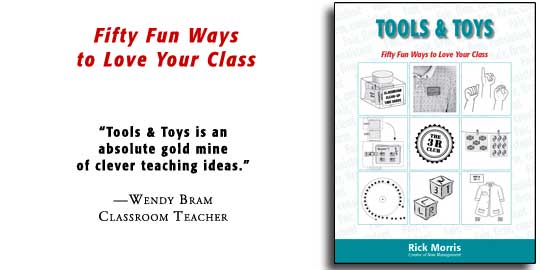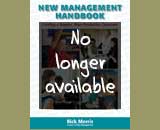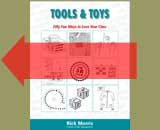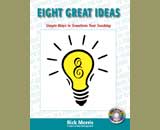

![]()
Introduction (from the book)
Read me.
I know, I know. You want to get to the good stuff. Nonetheless, take a moment and read the introduction. It will make the good stuff better.
Fair, Firm, Consistent
The tools and toys in this book were designed to promote and maintain two educational themes which I feel are crucial to effective education. The first one was championed at San Diego State University while I was an undergraduate working toward my elementary teaching credential. It's a simple teaching philosophy that can be summed up in three words: fair, firm, consistent. Fairness, firmness, and consistency are probably the three best traits a teacher could possess. Unfortunately, it's extremely difficult to consistently maintain a teaching style that reflects these principles without some kind of support mechanism. That's why I use the ideas in this book on a daily basis. They are, by design, models of fairness, firmness, and consistency.
Five Basic Needs
The other important principle comes from Bill Glasser's model for motivation based upon his control theory. In a nutshell, he states that students have five basic needs which must be met in order for them to immerse themselves in the learning process. These needs are: power, love, freedom, fun, and security. You will see these ideals woven into just about every tool and toy in this book. As you read, see if you can figure out which tools and toys supply which needs. Actually, since these needs are so critical to student achievement and success, you'll discover that many of these techniques incorporate more than one motivational factor. Moreover, as you begin to use them yourself, you'll find that meeting the needs of your students will produce a high degree of involvement, one of the key ingredients for effective education.
Enough philosophy...let's get down to practical matters.
Wingin' It
I've tried to keep the descriptions concise yet complete. Although I believe brevity is a blessing, I did not want to compromise the clarity of explanations by leaving out necessary details. So, if I sometimes ramble, I trust you will overlook it. Bear in mind, though, that some of the ideas might not be as fully explained as you would like. If that's the case, it's an opportunity to be creative. By allowing yourself to experiment with the ideas being presented, you'll be more likely to encounter success. So, if you find ambiguity, wing it. After all, these ideas are yours now. You own them. You--and your students--can decide how they're going to be put to best use.
Just Do It
Whenever possible, avoid the "pretty trap." I'm referring to the feeling I sometimes get when I'd like to make something for the classroom but want it to be just right. Experience has taught me that this desire has had a tendency to postpone the actual production process. I've come to realize, though, that it's more important to get the thing made and then worry about aesthetics when I have the time. An added advantage to the Just Do It principle is that, by living with the design for a period of time, I end up with a better understanding of how to make it both pretty and practical.
Take Your Time
Be patient. Education is a process. It's not a day-by-day series of unrelated events with the goal for the day being to survive 6 and 1/2 hours with your students. We're in it for the long run. Consequently, some of the processes and procedures we attempt to add to our learning environment might take several weeks of practice in order to be successful. However, once success has been attained, these techniques will be with us for the remainder of the school year. So, as you recreate these ideas for your room and introduce them to your students, keep an open mind when visualizing time frames. Although in your estimation the students should have been able to figure out an idea immediately, reality and ultimate success may require 30 days and a patient touch. Tools (and, more often, toys) that I've wanted to throw out by the third day are working beautifully by the third week. On the other hand, if it's not working after you've given it a good run, "bag it." As my grandfather taught me: "If the horse you're riding on dies, get off. It won't do you any good to change bits or adjust the saddle. Just get off and walk."
Involve the Students
Allow the students to run or manage as many of the tools as you possibly can. Although it is sometimes easier for you to run the show, you can, if not careful, perpetuate a "teacher welfare state" wherein students sit back and watch. One of the objectives of this book is the development of student responsibility. Like so many other things in life, responsibility is not something that comes about with age. It must be practiced to be gained. This is why so many of the ideas are designed for the students to use. By being necessary parts of these management tools, they get to exercise and practice responsibility on a daily basis.
Student Numbers
You will occasionally come upon ideas which make use of student numbers. (Chapter 4 is devoted to nothing but number-based tools & toys.) Each student in my room has a student number. It's added to the student name to help identify student assignments, textbooks, and supplies. Student numbers, along with the number tools I've created to take advantage of the organizational possibilities numbers offer, are the backbone of the New Management system of classroom management and student motivation. If you're currently using student numbers, you already know how effective this technique can be. If you're not using this type of system, merely substitute student names whenever you see numbers. The tools and toys will work just as well.
For more information on student numbers, check out the New Management Handbook: A Step-by-Step Guide for Creating a Happier, More Productive Classroom. In just ten easy lessons you'll learn how to take advantage of the power of student numbers.
Stretching Exercises
Please don't limit yourself to what you read. Allow the ideas to stimulate your own thinking. Starburst Math (page 37) was created by a junior high school mathematics teacher who had seen me demonstrate two separate tools: Name Tag Signs (page 58); and a ratty old lab coat I had found in a Goodwill store. I used to wear the lab coat as a motivational device for science or art or cooking or what-have-you. By merely donning the coat, I was transformed into someone special. Well, the above-mentioned math teacher combined the sign idea with the lab coat inspiration and came up with Starburst Math. Due to the power of synergy, this interactive math tool is a classic example of an idea whose whole is greater than the sum of the parts.
So, keep yourself open to other possibilities. Experiment, be playful, take risks, and don't forget to invite your students to add their own ideas and suggestions.
That's enough for now. Let's go have some fun.
Rick Morris
San Diego, California
January 1, 2008




